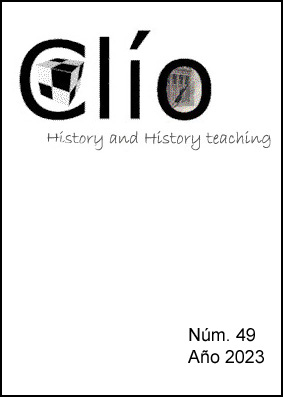The Eurocentric discourse in Baccalaureate Spanish textbooks of History of Art
DOI:
https://doi.org/10.26754/ojs_clio/clio.2023499578Keywords:
eurocentrism, textbooks, History of Art, teaching, identities, critical citizenship, discourse analysis , baccalaureateAbstract
This research analyzes the presence of Eurocentric discourse in the baccalaureate History of Art textbooks from a sociogenetic perspective. The sample is made up of textbooks belonging to publishers of Spanish national scope (Anaya, ECIR, Ediciones Ruiz, SM, Teide and Vicens Vives) in a chronology that includes the different periods through which the subject has gone through between 1953 and 2006. The study derives from the application of a document analysis script that includes, among its variables, the construction of identities. The results show the presence and sociohistorical resistance of Eurocentric discourse in the analysed History of Art textbooks, thus tending to the construction, reproduction and essentialization of ethnocentric identities. In this way, to delve into the formation of a critical citizenship, it is necessary to reconsider the approaches and purposes that base the History of Art school narrative in resources such as the one we are dealing with in this article.
Downloads
References
Bagué, E. y Vicens, J. (1970). Ars. Historia del Arte y de la Cultura. Teide.
Cajani, L. (Dir.). (2008). Conociendo al otro. El islam y Europa en sus manuales de historia. Fundación ATMAN-Santillana.
Cantonero, J. (2002). Una arqueología de la mirada o qué Historia del Arte estamos enseñando. Campo Abierto, 21, 83-96. Disponible en https://mascvuex.unex.es/revistas/index.php/campoabierto/article/view/4273
Cerón, C. P. (2011). Europeos y no europeos en manuales escolares de geografía universal, Colombia 1970-1990. Revista Historia de la Educación Latinoamericana, 16, pp. 57-86. Disponible en: http://www.redalyc.org/articulo.oa?id=86922549004
Cubilla, S. D. (2020). Eurocentrismo y orientalismo en los libros de texto de historia antigua de las escuelas secundarias de la Argentina (1890-1950). Revista del Instituto de Historia Antigua Oriental, 21, 153-179. https://doi.org/10.34096/rihao.n21.8656
Cuesta, R. (1997). Sociogénesis de una disciplina escolar: la Historia. Ediciones Pomares-Corredor.
De Azcarate, J. M., Pérez, A. E. y Ramírez, J. A. (1986). Historia del Arte. Anaya.
Dorio, I., Sabariego, M. y Massot, I. (2014). Características generales de la metodología cualitativa. En R. Bisquerra (coord.). Metodología de la investigación educativa (pp. 275-292). La Muralla.
Fanon, F. (1963). Los condenados de la tierra. Fondo de Cultura Económica.
Fernández, A., Barnechea, E. y Haro, J. (1983). Historia del Arte. Vicens Vives.
Fernández, A., Barnechea, E. y Haro, J. (1999). Historia del Arte. Vicens Vives.
Flick, U. (2004). Introducción a la investigación cualitativa. Ediciones Morata.
García-Sinausía, S. y Valtierra, A. (2021). Historia del Arte en la LOMCE y la LOMLOE: ¿hacia una igualdad de género real? En L. Álvaro y C. Hamodi, (Coords.), Género y educación: escuela, educación no formal, familia y medios de comunicación. Dykinson.
Lander, E. (Compil.). (2000). La Colonialidad del Saber: Eurocentrismo y Ciencias Sociales. Perspectivas Latinoamericanas. CLACSO.
Levitt, P. & Rutherford, M. B. (2019). Beyond the West: Barriers to Globalizing Art History. Art History Pedagogy & Practice 4(1). https://academicworks.cuny.edu/ahpp/vol4/iss1/2
Llacay, T., et al. (2005). Nuevo Arterama. Historia del Arte. Vicens Vives.
López-Castelló, R. (2021). Epistemología y renovación en la Historia del Arte. Una experiencia práctica en Bachillerato. Íber. Didáctica de las Ciencias Sociales, Geografía e Historia, 104, 47-53.
López-Facal, R. (2010). Nacionalismos y Europeísmos en los Libros de Texto: Identificación e Identidad Nacional. Clío & Asociados. La Historia enseñada, 1(14), 9–33. https://doi.org/10.14409/cya.v1i14.1673
López, R. y Monteagudo, J. (2016). Las Pruebas de Acceso a la Universidad de la asignatura de Historia del Arte. Análisis de su estructura y contenido. Didáctica de las Ciencias Experimentales y Sociales, 30, 45-64. DOI: https://doi.org/10.7203/dces.30.4314
Martínez, I., Martínez, J. A. y Martínez, J. (2000). Historia del Arte. ECIR.
Mast, K. (2019). The Art History Canon and the Art History Survey Course: Subverting the Western Narrative. The Journal of Social Theory in Art Education, 39, 31-51. https://scholarscompass.vcu.edu/jstae/vol39/iss1/5/
Nelson, R. S. (1997). The Map of Art History. The Art Bulletin, 79(1), 28-40. https://www.jstor.org/stable/3046228?seq=1#metadata_info_tab_contents
Osorio, L. y Balbuena, C. (2013). Latinoamérica vista desde el paradigma eurocéntrico: un análisis de los textos escolares de historia universal. Tiempo y Espacio, 60, 49-69. Disponible en http://ve.scielo.org/scielo.php?script=sci_arttext&pid=S1315-94962013000200004&lng=es&tlng=es
Parra, D., Sáiz, J. y Valls, R. (2021). La enseñanza de la historia, una cuestión de identidad. En C. Gómez, X.M. Souto y P. Miralles (eds.). Enseñanza de las ciencias sociales para una ciudadanía crítica (pp. 159-172). Octaedro.
Pérez-Garzón, J. S. (2008). ¿Por qué enseñamos Geografía e Historia? ¿Es tarea educativa la construcción de identidades? Historia de la educación, 27, 37-55. https://revistas.usal.es/index.php/0212-0267/article/view/1596
Ramírez, J. A., et al. (2003). Historia del arte 2º Bachillerato. SM.
Said, E. W. (2016). Orientalismo (obra original publicada en 1978). Debolsillo.
Tadeu da Silva, T. (2001). Espacios de identidad: nuevas visiones sobre el currículum. Octaedro.
Valls, R. (1994). La imagen de Europa en los actuales manuales escolares españoles de Ciencias Sociales. Didáctica de las Ciencias Experimentales y Sociales, 8, 3-26.
Wallerstein, I. (2001). El eurocentrismo y sus avatares: Los dilemas de las ciencias sociales. Revista De Sociología, 15, 27–39. https://doi.org/10.5354/0719-529X.2001.27767
Downloads
Published
How to Cite
Issue
Section
License
Copyright (c) 2023 Raúl López-Castelló, David Parra-Monserrat

This work is licensed under a Creative Commons Attribution-NonCommercial-ShareAlike 4.0 International License.
This work is licensed under a Creative Commons Attribution-NonCommercial-ShareAlike 4.0 International License.
Copyright remains the property of authors. Permission to reprint must be obtained from the authors and the contents of JoS cannot be copied for commercial purposes. JoS does, however, reserve the right to future reproduction of articles in hard copy, portable document format (.pdf), or HTML editions of JoS.
Funding data
-
Ministerio de Ciencia e Innovación
Grant numbers PID2021-122519OB-I00 -
European Regional Development Fund
Grant numbers PID2021-122519OB-I00 -
Ministerio de Universidades
Grant numbers FPU18/03756






